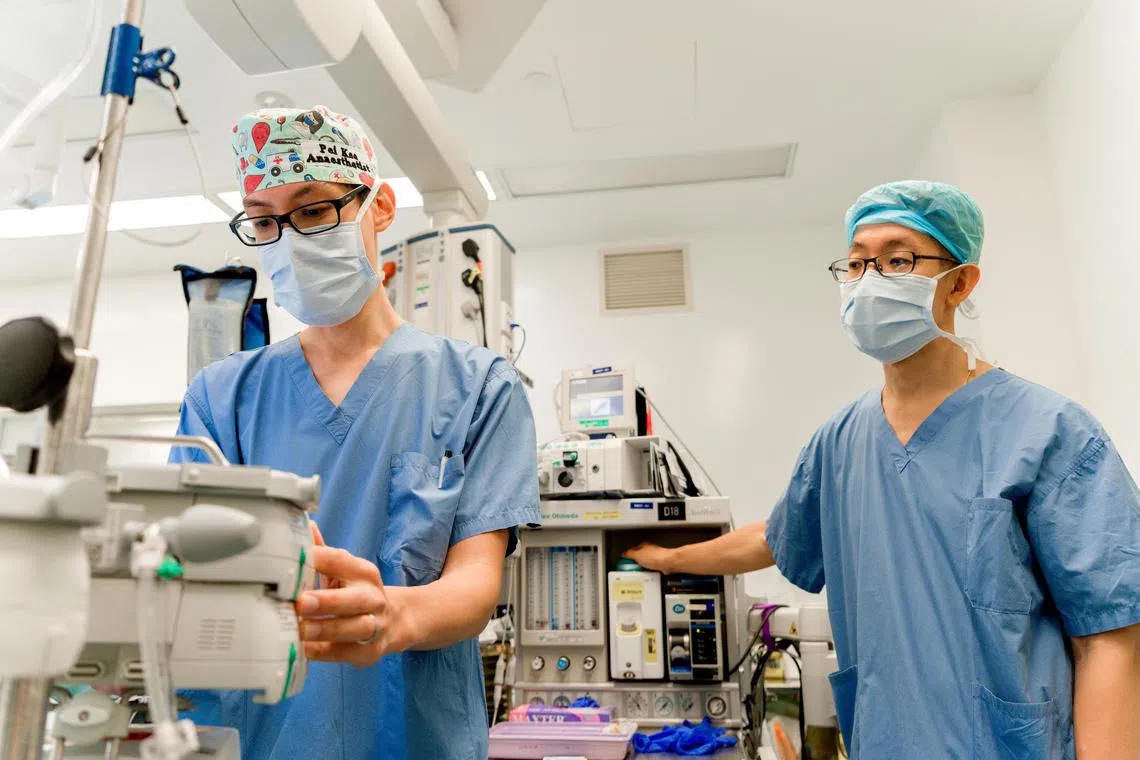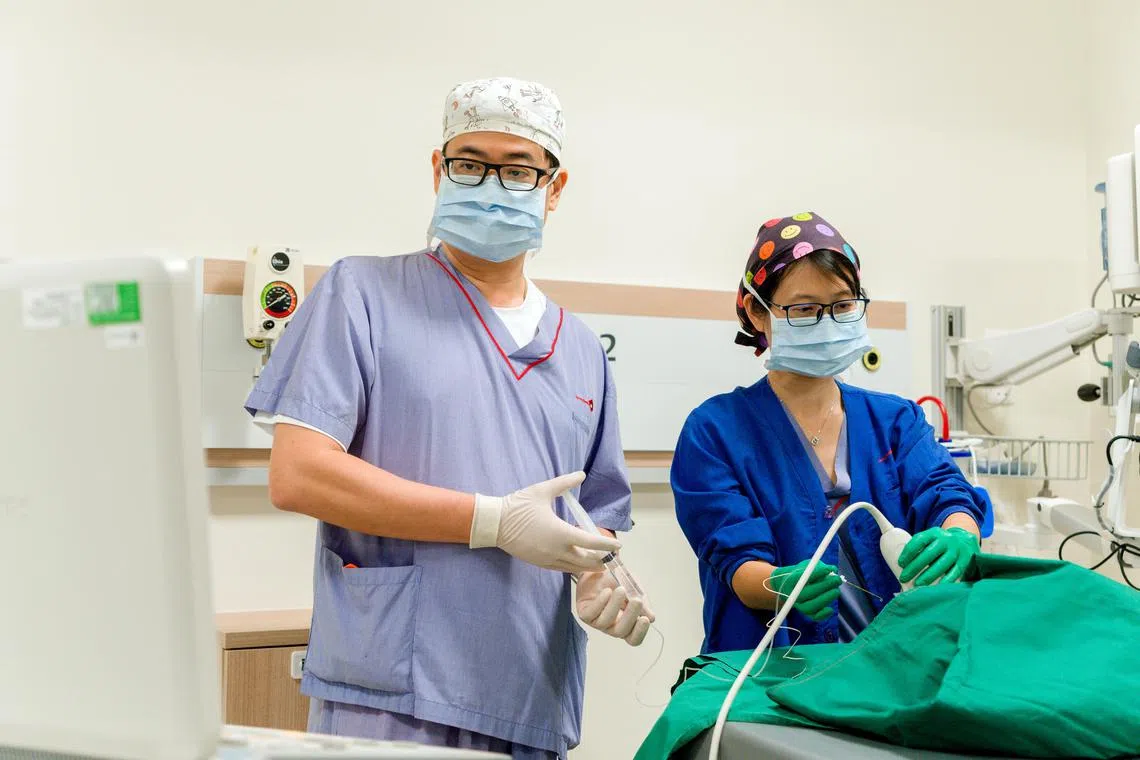Hospitals cut back on environmentally unfriendly anaesthetic gases, reducing CO2 emissions
Sign up now: Get ST's newsletters delivered to your inbox

Dr Poh Pei Kee (left), a consultant at National University Hospital's department of anaesthesia, and senior consultant Bryan Ng using an alternative gaseous agent during a surgical procedure.
PHOTO: NUHS
Follow topic:
SINGAPORE - Hospitals are switching to more environmentally friendly anaesthetic gases for patients undergoing operations.
This is part of efforts by the public healthcare sector to go green as hospitals here cut back on the use of some anaesthetic gases with high carbon footprint because of how damaging they can be to the environment.
All anaesthetic gases are greenhouse gases and their impact is measured by their Global Warming Potential (GWP), which measures how effective each gas is at trapping heat in the atmosphere over time compared with carbon dioxide (CO2). This is most often calculated over a 100-year timescale.
Desflurane, which has been banned in Scotland due to its impact on the climate, has a GWP of 2,590. This means it is 2,590 times more potent than carbon dioxide in warming the Earth. Another gas, nitrous oxide, which is commonly used as an adjunct in general anaesthesia, has a GWP of 273. This is according to figures from Dr Poh Pei Kee, a consultant at National University Hospital’s (NUH) department of anaesthesia.
Hospitals here said they are trying to reduce usage of both gases where medically appropriate. More efforts have been directed towards desflurane because of its larger environmental impact.
According to a written answer to a parliamentary question by Workers’ Party MP Leon Perera on desflurane use on April 21, the Ministry of Health (MOH) said the usage of the gas has dropped. In 2019, the proportion of desflurane use ranged from 28 per cent to 68 per cent across the different healthcare institutions. This decreased to a range of 5 per cent to 42 per cent in 2022.
Dr Poh said NUH initiated a quality improvement project to reduce the use of desflurane in 2021. The hospital invited international speakers to give talks on how other countries were moving ahead in this area, reminded clinicians of the cost and environmental implications of the gas through stickers pasted on anaesthetic machines, and promoted the use of alternatives, he said.
This saw a 90 per cent reduction in the use of desflurane at NUH between April 2021 and March 2023, saving the hospital over $577,000 and 1,904 tonnes in CO2 emissions, equivalent to taking 680 cars off the road.
For Ng Teng Fong General Hospital (NTFGH), its use of desflurane has dropped 34 per cent from 107 litres in 2019 to about 71 litres in 2022. This could be because of awareness and education efforts on the impact of desflurane, said Dr Chan Hean Peng, associate consultant at NTFGH’s department of anaesthesia.

Ng Teng Fong General Hospital’s head of anaesthesia, Dr Terry Pan (left), and associate consultant Dr Chan Hean Peng showing how regional anaesthesia may be performed.
PHOTO: NUHS
Changi General Hospital (CGH) said it has also been actively reducing its desflurane usage since 2019, by engaging staff and reminding them of the environmental impact of the gas.
Dr Jo-Anne Yeo, a consultant at CGH’s department of anaesthesia and surgical intensive care, said that besides education efforts, the hospital has also limited access to desflurane vapourisers, making it available only on demand, and necessitating extra effort if desflurane is used. This is done while avoiding any risk of compromising patient safety, she added. The hospital did not share any figures.
In moving away from desflurane, doctors said the next best alternative is the gas sevoflurane. It has a GWP of 144, and is about 20 times less harmful to the environment in terms of trapping heat, compared with desflurane. Hospitals like CGH and NUH have also made efforts to convert usage to lower gas flows, so that less anaesthetic gas is used and lost to the environment.
The other options are to use propofol, a drug administered intravenously to keep patients asleep; or to turn to regional anaesthesia instead of general anaesthesia where appropriate, with no anaesthetic gas used at all, doctors added.
Common operations where regional anaesthesia can be used instead of a general anaesthesia are total knee replacements and caesarean sections for delivery, said Dr Kenny Loh, head of anaesthesiology at Singapore General Hospital.
But it is still not possible to do away entirely with desflurane, doctors say.
“It is sometimes still necessary to use desflurane despite its higher carbon footprint, because it is the most titratable and allows the most rapid recovery of patients from general anaesthesia,” said Dr Alvin Tan, a consultant at Khoo Teck Puat Hospital’s department of anaesthesia.
This can be useful in surgery involving the airway and in patients with a higher risk of airway obstruction due to the effects of anaesthesia, such as obese patients, he added.
CGH’s Dr Yeo also pointed out that many clinicians are still more familiar with the use of desflurane over sevoflurane. “To allow specialists time to gain the required clinical experience with changed practices, the option of desflurane for occasional situations would be our current preferred course of action,” she added.
There is also a need to take into consideration global supply chain issues, said Dr Yeo, adding that if the supply of sevoflurane gets disrupted, it could affect the hospital’s surgical operations.
“Thus, it is not ideal to rely on sevoflurane as the only main inhalational alternative. As we strive towards the reduction of desflurane usage, we hope to still keep desflurane readily available until a second inhalational anaesthetic gas alternative becomes available,” she said.
Hospitals under the National Health University System cluster, which includes NUH, NTFGH and Alexandra Hospital (AH), are also planning on making more concerted efforts to reduce the use of nitrous oxide as it is better for the environment.
AH has taken the lead by shutting off its nitrous oxide pipelines. This has resulted in cutting 1,100 tonnes per year of carbon dioxide equivalent emissions, translating to about 5 per cent of the total emissions of the hospital.
Dr Addy Tan, a senior consultant at AH’s department of anaesthesia, explained that use of nitrous oxide for general anaesthesia has come down drastically in recent years because of its multiple side effects and the availability of other replacement anaesthetic gases such as sevoflurane.

Alexandra Hospital’s head of anaesthesia Addy Tan (right) and resident physician Shree Venkatesan using a technique called total intravenous anaesthesia to keep patients asleep during operations that do not require any anaesthetic gas, and cuts the greenhouse effect.
PHOTO: NUHS
In addition, unlike desflurane and sevoflurane, nitrous oxide is supplied from cylinders connected to the operating theatres via gas pipes and the pipelines were old. A decision was made to shut down the pipelines after leaks were found following an investigation, and taking into account the low usage and environmental impact of the gas.
“For patients who require nitrous oxide for clinical indication, the gas can still be provided by the local smaller cylinders attached to the anaesthesia machines; however the volume is expected to be minimal. This greatly reduces the overall consumption of nitrous oxide and allows for better accountability,” said Dr Tan.
He added that discussions are ongoing with NUH and NTFGH to eventually shut down the nitrous oxide pipeline supply, with a solution for a reliable alternative supply still being worked on.


